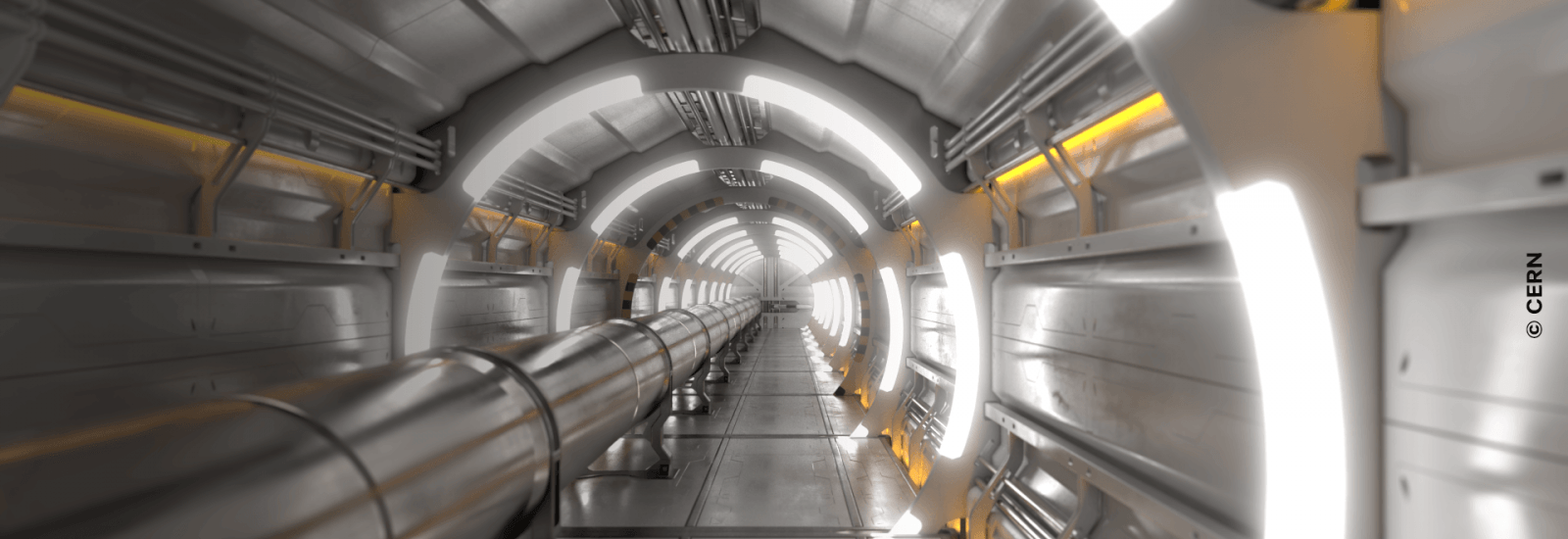The Large Hadron Collider (LHC) has a circumference of 26.659 km, making it the largest particle accelerator currently available to the global research community. The LHC has been used, for example, to confirm the existence of the Higgs boson for which François Englert and Robert Higgs were awarded the Nobel Prize in Physics in 2013. But every discovery raises new questions that require further development of the technical equipment to answer. The LHC accelerates proton bunches to up to 99.9999991 percent of the speed of light. This corresponds to a center-of-mass energy of 14 teraelectronvolts (TeV). Sounds like a lot? But it’s not enough.
Research into dark matter, baryon asymmetry and other aspects of particle physics that the Standard Model cannot explain requires much higher center-of-mass energies. A new ring accelerator, the Future Circular Collider (FCC), is intended to remedy the situation. According to initial theoretical considerations, the facility, which will cover about 100 kilometers, is expected to generate a center-of-mass energy that is up to ten times higher. The exact values will not be known until the feasibility study has been completed, probably in 2026. Until then, the project team is investigating several variants that require different technical developments. An even larger hadron accelerator would need superconducting magnets twice as strong, for instance.
What Happens Vacuum-Wise in the Particle Accelerator?
A particle accelerator consists of a ring of dipole magnets enclosing two tubes running parallel to each other, each only a few centimeters in diameter. In these so-called beam pipes, proton bunches orbit in opposite directions so that they can collide with each other. To prevent the accelerated particles from colliding with gas molecules in the residual air, the vacuum in the tubes must be as perfect as possible.
This is why all particle accelerators are subject to an ultra-high vacuum in the important components. In places, this vacuum is as extreme as the machine itself. In the best case, a pressure of 10-16 bar is achieved. This corresponds to the atmospheric pressure on the surface of the Earth's moon - which most people assume has no atmosphere at all!
A vacuum is also needed to operate the numerous superconducting electromagnets that guide and focus the particle beams, albeit "only" a high vacuum. Finally, supply lines enclosed by a vacuum transport the liquid helium that cools the magnets to a temperature near absolute zero and allows superconductivity. The enclosing vacuum ensures the best possible reduction in heat flow.
The Challenge for Valves Is Great
To generate this level of vacuum in the particle accelerator means valves are required everywhere. Not only do they regulate the controlled inflow and outflow of gases, but as sector valves they also allow a section of the accelerator to be sealed off for maintenance purposes or, as so-called beam stoppers, they also ensure the rapid interruption of particle or energy radiation in the accelerator system. They all have to withstand very high stresses resulting from the extremely low vacuum, locally high temperatures and the intense radiation that always occurs in particle accelerators. This is why elastomers are not suitable as seals for use in accelerators; they would dry out and disintegrate. All-metal valves are required.
All-metal valves are free of any elastomers; they seal "hard-on-hard". That is, the plate and bonnet seals are fitted with metal seals. This not only makes them resistant to the extreme ambient conditions, but also allows very high bakeout temperatures which can be used to remove any possible remaining adsorbed substances on the surfaces of the valves. Bakeout temperatures can be as high as 300°C, in both open and closed valve positions.
The special VATSEAL seals used by VAT as bonnet seal or flange seal have particularly good formability properties. The seals, which are made of silver-coated copper, offer elastic properties that allow them to adapt particularly well to the surface contours of the sealing surfaces and thus provide an optimum seal even at very high differential pressures.
For the plate seals, VAT uses its special VATRING sealing technology. This dynamic all-metal sealing system is able to provide reliable sealing over the long term and generate constant closing forces. It enables high sealing forces with comparably low axial forces. The sealing partners are made of stainless steel, silver-coated and deform only elastically. This means that where other metal seals would have to be replaced after a closing operation because they would be deformed, VATRING technology allows repeated closing because the seal returns to its original shape. This significantly reduces the maintenance required for all-metal valves, ultimately saving time and money. No wonder, then, that VAT's collaboration as the market leader for all-metal valves with accelerator projects such as the 100-kilometer collider at CERN is a long-standing and promising one.
